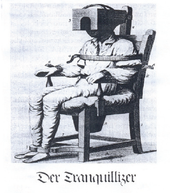Forced chair
The forced chair was a compulsory somatotherapeutic treatment and sometimes also a punishment in psychiatric institutions. Patients were in it with leather straps or other means fixed , so that they "quiet, sober and obedient" were. In the middle of the seat there was a hole for feces. The coercive chair was invented as the Tranquilizer Chair in 1811 by psychiatrist Benjamin Rush .
Peter Joseph Schneider reported in 1824 about forced sitting according to Ernst Horn : “An armchair made of solid wood with a high seat and strong arms with a movable back, in which the lunatic is fastened by means of a wide chest strap, arm, hand and foot straps . At the same time a device is attached by which the backrest can be raised or lowered, for those cases in which the patient makes impetuous movements with the head, which can be immediately rendered harmless by lowering the upper part of the backrest. "
The duration of the fixation could be up to 24 or even 48 hours. At least one death is documented: In Haina in 1853 a patient died after twenty-nine hours in a forced chair. In another case, a patient was even confined to the forced chair for a full six months in a row.
Historical forced chairs are among others in the psychiatry Museum Haina and Psychiatry Museum Philippshospital issued.
Individual evidence
- ↑ Peter Joseph Schneider : Draft for a doctrine of remedies against mental illnesses. Tuebingen 1824
- ↑ Helmut Siefert : The forced chair. An example of how the mentally ill were dealt with in Haina in the 19th century. In: Walter Heinemeyer , Tilman Pünder (Hrsg.): 450 years of psychiatry in Hessen (= publications of the historical commission for Hessen. Volume 47). Elwert publishing house. Marburg 1983, pp. 309-320.
- ↑ http://www.uphs.upenn.edu/paharc/features/brush.html
- ↑ Peter Joseph Schneider : Draft for a doctrine of remedies against mental illnesses, or remedies in relation to forms of mental illness. Volume 2, 1824, p. 605
- ↑ Gesa Coordes: Haina Psychiatry Museum: “Raging people” in chains and in the “hollow wheel”. In: Deutsches Ärzteblatt , 1996; 93 (44): A-2886 / B-2454 / C-2298
- ↑ Vitos Haina, History - The new "curmethods"
- ^ Emil Kraepelin: Hundred Years of Psychiatry: A Contribution to the History of Human Morality. 1918, page 9 ( digitized version )
